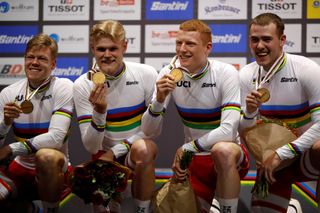Track cycling: What is the Team Pursuit
Four riders over four kilometres against the clock

Track cycling is one of the original sports contested in the modern Olympic Games, when they were restored in 1896 at Athens, Greece. Track cycling was one of 43 total events contested by 280 athletes, all men, from 13 nations and its multiple disciplines have appeared in all but one Olympic Games since, with the exception of Stockholm 1912 when only a time trial was held.
The Team Pursuit is considered an endurance event, even though the times are around four minutes for women and have dipped below the four-minute mark for men for the 4,000-metre race. It’s about clockwork precision in addition to high speed.
The Team Pursuit was first an Olympic event for men in 1908 with the women added to the programme in 2012.
In the first appearance, women raced with three-rider teams over a 3,000-metre distance, but starting in 2016 in Rio, both men's and women's events used four-rider teams competing over 4,000 metres.
The best time for both men and women in the Olympics are held by Great Britain, who set records at the 2016 Rio Games, both for the women's event with a 4:10.236 (also a World Record), and for the men with 3:50.265.
Basics of Team Pursuit
Each team is composed of four riders who race together across 16 laps (4,000 kilometres), each taking turns pulling with the others drafting in a straight line.
Each round is contested by two teams starting on opposite sides of the track to cover the 4,000. The time is taken as the third rider's front wheel crosses the finish line.
One of the most graceful cycling events, the lead rider powers the team into a turn then pulls off high on the banking and dives down to rejoin in the draft of the last rider. The better a rider is at pulling off an effective exchange, the more efficient they are at saving energy and thus the faster they can travel.
The event combines technical skill, equipment innovation for maximum aerodynamics as well as pacing and strategy. Stronger riders might take longer pulls or save their strength for late in the race. Weaker riders might bury themselves for as long as possible before being dropped. Riders must know each other's abilities well and ensure that at least three riders stay together to the finish.
Teams are allowed to enter five riders and combine in different ways into teams of four for each round.
If a team makes the final, they will have endured three rounds: the first is a qualifying round where each team is on the track alone, aiming to set their fastest possible time. Only the top four teams have an opportunity to race for the gold medal, while the next four fastest may only at best earn bronze.
On the next round (called the first round), the teams face off according to their ranking in qualifying: 6th vs 7th, 5th vs 8th, 2nd vs 3rd and 1st vs 4th. The winners of the last two heats will compete for the gold medal in the final.
The times of losers of the last two heats are grouped together with the first two heats, and the two fastest teams of those six will make the bronze medal final.
The medals are then awarded in another head-to-head round where the fastest team wins. If a team gets within one metre of catching their opponent, they win automatically.

Thank you for reading 5 articles in the past 30 days*
Join now for unlimited access
Enjoy your first month for just £1 / $1 / €1
*Read any 5 articles for free in each 30-day period, this automatically resets
After your trial you will be billed £4.99 $7.99 €5.99 per month, cancel anytime. Or sign up for one year for just £49 $79 €59

Join now for unlimited access
Try your first month for just £1 / $1 / €1
Get The Leadout Newsletter
The latest race content, interviews, features, reviews and expert buying guides, direct to your inbox!

Jackie has been involved in professional sports for more than 30 years in news reporting, sports marketing and public relations. She founded Peloton Sports in 1998, a sports marketing and public relations agency, which managed projects for Tour de Georgia, Larry H. Miller Tour of Utah and USA Cycling. She also founded Bike Alpharetta Inc, a Georgia non-profit to promote safe cycling. She is proud to have worked in professional baseball for six years - from selling advertising to pulling the tarp for several minor league teams. She has climbed l'Alpe d'Huez three times (not fast). Her favorite road and gravel rides are around horse farms in north Georgia (USA) and around lavender fields in Provence (France), and some mtb rides in Park City, Utah (USA).